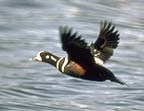
Injury Harlequin ducks spend most of their time in intertidal and shallow subtidal habitats where much of the oil was initially stranded. In Prince William Sound, about 150 harlequin duck carcasses were collected immediately after the Spill in 1989. From these recovered birds, it was estimated that 1,000 harlequins were killed by the initial oiling event, which represented about 7 percent of the wintering population. In addition to acute effects, harlequin ducks were one of the few species for which chronic injury related to long-term exposure to lingering oil was documented.
Harlequin ducks spend most of their time in intertidal and shallow subtidal habitats where much of the oil was initially stranded. In Prince William Sound, about 150 harlequin duck carcasses were collected immediately after the Spill in 1989. From these recovered birds, it was estimated that 1,000 harlequins were killed by the initial oiling event, which represented about 7 percent of the wintering population. In addition to acute effects, harlequin ducks were one of the few species for which chronic injury related to long-term exposure to lingering oil was documented.
Recovery Objective
Harlequin ducks will have recovered when breeding- and non-breeding-season demographics and biochemical indicators of hydrocarbon exposure in harlequins in oiled areas of Prince William Sound are similar to those in harlequins in unoiled areas.
Recovery Status
Winter populations of harlequin ducks in Prince William Sound have ranged from a high of 19,000 ducks in 1994 to a low of around 11,000 ducks in March of 1990, one year after the Spill. The 2010 estimate of wintering harlequin ducks in the Sound was approximately 15,425.
Several post-Spill studies were designed to measure the extent and severity of injuries to the Prince William Sound harlequin duck population from the oil Spill and assess recovery. Through 1998, oil Spill effects were still evident although the extent and magnitude of the injury remained unclear. Supporting studies provided evidence of continuing injury to harlequins through the following mechanisms: 1) invertebrate recovery in upper intertidal and subtidal areas remained incomplete for some species, thereby impacting potential prey base for harlequins; 2) oil persisted in intertidal areas of Prince William Sound where it was identified as a source of contamination of benthic invertebrates; 3) the possibility of external oiling of feathers remained due to lingering oil; 4) the possibility of oil ingestion while digging for prey in the subsurface; 5) a biochemical marker of oil exposure (cytochrome P450) was higher in tissues of harlequin ducks captured in oiled areas than in reference areas and 5) overwinter female survival was lower in oiled than reference areas.
 From 1997-2007, age composition and numerical trends were compared in harlequin ducks between oiled and unoiled areas of the Sound. No difference in population trends was observed between areas. Although populations in the oiled area were no longer declining as they were in the mid-1990s, a positive trend was not observed. Overall, more males than females occurred Sound-wide which is consistent with other Pacific populations of harlequin ducks. The ratio of immature to adult males was similar between areas, thus indicating similar recruitment into both populations. However, there remained a disproportionately lower number of female ducks in the oiled areas. From 2000-2002, female survival rates were similar between oiled and unoiled areas. However, in 2005 through 2011 the P450 biomarker was elevated in ducks from the oiled areas. Finally, lingering oil appeared to remain in habitats used by harlequins, thereby maintaining the possibility of chronic effects related to continued exposure.
From 1997-2007, age composition and numerical trends were compared in harlequin ducks between oiled and unoiled areas of the Sound. No difference in population trends was observed between areas. Although populations in the oiled area were no longer declining as they were in the mid-1990s, a positive trend was not observed. Overall, more males than females occurred Sound-wide which is consistent with other Pacific populations of harlequin ducks. The ratio of immature to adult males was similar between areas, thus indicating similar recruitment into both populations. However, there remained a disproportionately lower number of female ducks in the oiled areas. From 2000-2002, female survival rates were similar between oiled and unoiled areas. However, in 2005 through 2011 the P450 biomarker was elevated in ducks from the oiled areas. Finally, lingering oil appeared to remain in habitats used by harlequins, thereby maintaining the possibility of chronic effects related to continued exposure.
In 2013 studies, hepatic CYP1A levels in harlequin ducks, based on EROD activity, were similar between areas oiled during the Spill and in nearby unoiled areas. This constitutes the first time since initiation of harlequin duck CYP1A sampling in 1998 that EROD activity has not been higher in oiled areas than in unoiled areas of Prince William Sound. This would indicate that harlequin ducks are no longer exposed to residual oil from the Spill.
Harlequin ducks are considered to be recovered, as indications of negative effects (reduced survival and declining numbers) in oiled areas have abated and breeding- and non-breeding-season demographics in oiled and unoiled areas have converged.
Click HERE for more information on Trustee Council funded studies of harlequin ducks.
